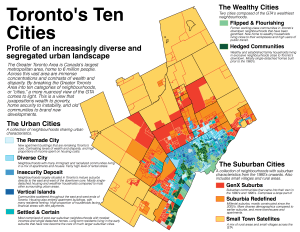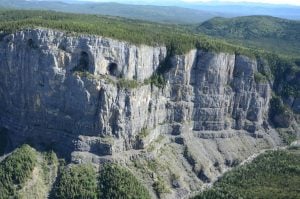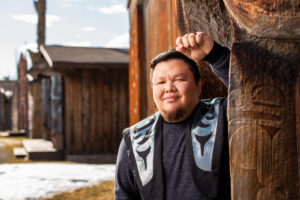
Mapping
The geographer that mapped the cities within the city
Urban geographer Liam McGuire on how he used maps to illustrate growing inequalities in Canadian cities
- 1801 words
- 8 minutes
This article is over 5 years old and may contain outdated information.
Travel
A culinary tour of the emirate known for its ‘seven star’ luxury bewitches and bewilders a Canadian novelist

I went off on a foodie adventure tour of Dubai.
I knew rather little about the place, other than its reputation for being luxurious. I’d read that it has seven-star hotels. But if five out of five is a perfect score, then what do the sixth and seventh stars stand for?
The first taste I get of Dubai is on the Emirates Airlines flight there, aboard an A380, a plane that has almost become legendary for having private suites and showers and a bar. I have very long legs and usually feel like I’m trying to fold a complicated chair when I sit down in planes. But the chair in my business-class private pod is more comfortable than the armchair I write in at home. It’s always a drag to sleep next to someone on an overnight flight, but I’m amazed at how secluded I feel; all I can see of the man next to me is his feet and his television screen, on which he is watching a film about an attractive delivery man who is in charge of transporting two kangaroos.
I usually look forward to food on a plane because it kills time even though it’s awful. In this case, a splendid menu is handed to me. I order the shrimp and lobster appetizer and a fish entrée on rice with vegetables. They are served beautifully, on plates, restaurant style. An assortment of wines is offered.
The point of luxury is to make you forget entirely about reality. I write a fairly inspired piece of fiction in my pod. I press a button on the side of my chair, and it turns into a bed. A flight attendant arrives with a mattress. Little stars appear in the ceiling over my head. I am enchanted.

I immediately assess that Dubai’s most defining feature has to be its skyscrapers. For me, skyscrapers are by definition ugly. They are utilitarian and cheap looking. But the skyscrapers in Dubai are architectural feats, spiralling and twisting into odd angles. They are pretty impressive. But beautiful? Everything is linear in Dubai. There is nothing that imitates nature in the design of these buildings. But, then again, it is a city erected in a desert.
I go to the top of the world’s tallest building, the 830-metre Burj Khalifa, for high tea at At.mosphere restaurant. There are cookies and square sandwiches served on four-layer golden trays. There are stacks of colourful macarons. It reminds me of the dishes brought to Marie Antoinette in a movie I’d seen set in Versailles. Now Versailles — that is a place of similar opulence, which is indisputably beautiful from any angle.
I walk over to the window, look down and am met with a phenomenal sight: Dubai from above. In most cities, the spectacle of it all is achieved by looking up. But Dubai, I realize, needs to be seen from a height because from up here it resembles pop art. The pools are gorgeous blue circles. The roads are in swirling configuration. There is order in the mad excess, the frenzy, of new construction. It is beautiful.
In most cities, the spectacle of it all is achieved by looking up. But Dubai, I realize, needs to be seen from a height because from up here it resembles pop art.
I am staying at the W Dubai Al Habtoor City hotel. You have to be careful where you drink in Dubai, and you are supposed to wear modest clothing — a dress that goes below your knees, say — in respect of local customs. But I am informed that in hotels you can do whatever the hell you want. The W turns into some sort of nightclub when the sun goes down. There are lineups to the elevator, which is packed with women with masses of coiffed hair wearing miniskirts and ridiculously high heels. They look fantastic and keep admiring themselves in the reflection of the elevator walls. I don’t know where they’re going. I don’t bother to find out. Also, I haven’t brushed my hair since I was in Grade 4, so it’s not my scene.
I’m late for dinner at Namu, the Korean-Japanese restaurant on the hotel’s 28th floor. By the time I arrive, the table is already spread with sushi rolls, which are madly delicious. I immediately start hogging the salmon sashimi, as is my way. The woman next to me asks if I want to hang out with a prince later. I shrug — what’s there to talk about with a prince?
I look out the window and am surprised to see something I’ve seen so many reproductions of that actually looking at it now, in person, is surreal: a crescent moon hanging upside down, and to its right, a single star.


In the morning, I am off to Old Dubai, a part of town that isn’t especially antique, having been built in the 1980s. I walk through a market that sells scarves and lamps and random trinkets. The shopkeepers keep calling me Shakira. The tour guide assures me they call every woman Shakira, or some other random celebrity, to get their attention. Personally, being called Jessica Chastain would get mine.
At the nearby spice souk, the enormous barrels of assorted spices are resplendent with colours, reminding me of the feeling of opening a new box of crayons when I was a child. I pass the gold souk, where mannequins in windows are dripping with gold, and imagine myself returning to Montreal bedecked in jewels, my friends having to wear sunglasses to speak to me.
But I mustn’t forget about the food. On a Frying Pan Adventures tour called the Middle Eastern Food Pilgrimage, I follow a young guide who adores Dubai and tells wonderful historical tales about it as we pass buildings that have a makeshift, North American suburban strip mall feel. Our first stop is for falafel. The guide explains that every country in the Middle East claims it invented the falafel.
I’ve never been crazy about falafel, to be honest. It’s usually kind of dry and a tad bland. I buy it and stick it in my purse when I’m late to a movie, and eat it when the sound of my stomach rumbling begins to interrupt serious scenes. But these falafels are moist and green and filled with delightful creamy chickpea flavour. My entire understanding of what falafel tastes like changes at that moment. It is the best falafel I have ever eaten.
At a traditional Emirati restaurant, I sample Bedouin-style cuisine. The restaurant is in an utterly nondescript building, the type of place that might be temporarily rented out by a campaigning politician.
I take my shoes off and sit on a pillow on the floor. Large bowls of goat and chicken and beef are placed in front of me, along with rice. You don’t get utensils at a traditional Emirati restaurant. Rather, you put a dollop of yogurt into your bowl to hold the rice and meat together. On the floor next to the pillows, there are boxes of Kleenex to wipe your hands with. The meat is delicious and tender, simmering in the flavour of spicy, rich sauce.

We stop at a shop that sells baklava, each of which has a different name. I see one shaped like a nest with nuts that look like small eggs in the centre. It is called The Nest of the Nightingale. How exquisite! The name is like a poem, I think, as I pop it in my mouth.
Another one is called A Baby Finger, which seems a tad macabre. I pop it in my mouth, nonetheless.
I go to another restaurant to eat a dessert, and am led into the kitchen where the dessert — some sort of butter concoction — is being made on the stove. It’s too hot for me, so I wander into the back of the restaurant, where there’s a large aquarium with a large photograph of a sheik above it and a bubble gum machine next to it. Outside, there’s a skinny cat who has spilled its food on the ground. This more ramshackle Dubai may not be that old, but it is lovely in an endearing way.
If you want to know what Dubai is like, then look at this pudding. It is trying to do something spectacular just beyond the traditional limits of luxury.
In the evening, I am back in New Dubai and am going to eat at an Italian restaurant. This at first seems absurd. Why would I go to an Italian restaurant in Dubai? Because it is the nature of New Dubai. It is the realm of ex-pats, of a mix of people coming and going from all over the world. The restaurant is called The Artisan. It’s supposedly where celebrities hang out. “Check out Shakira over at that table,” a woman next to me says. I look over at a table, expecting to actually see Shakira. But she has picked up the local custom of calling women Shakira.
The cocktails are spectacular. One woman has hers served in a glass in the shape of a sea shell with a straw poking out. Another has a cocktail that comes in a Chinese takeout container. Mine has a tiny clothes peg holding a flower on the side of the glass. I am jealous of the others.
There is some sort of pudding in a cup. There is an arrangement of chocolate shooting out of it that resembles trees. I photograph it. I text the photo back to Montreal. If you want to know what Dubai is like, then look at this pudding. It is trying to do something spectacular just beyond the traditional limits of luxury.

I’m riding in a van on Arabian Adventures’ New Dubai City tour. The German tour guide rambles about the different neighbourhoods we pass. She points out a Tim Hortons and says that when the shop opened, no one in Dubai had any idea who Tim Hortons was and what he had to sell. Then she laughs.
The guide stops the van for a few minutes outside the Burj Al Arab, considered one of the most luxurious hotels in the world and which resembles the sail of a dhow, a traditional Arab boat. We then walk along the beach, and the guide points to the water, explaining how off the coast of Dubai are groups of artificial islands, one set of which is built to resemble a map of the world. I ask the guide to repeat this, because I can neither believe it nor understand the point.
I jump out for a photo in front of the great pink archway of the Atlantis, The Palm hotel, which is at the apex of the palm-tree-shaped island. This hotel is based on the myth of Atlantis, has a waterpark inside and is known to host Kim Kardashian when she is in town. We pass the Mall of the Emirates, which contains an indoor ski hill, and then actually go into another shopping centre, the Dubai Mall, where we walk through an underwater tunnel — part of the Dubai Aquarium — as sharks swim over our heads.
“How does this compare to the Toronto Aquarium?” I ask a woman next to me.
“We’re in a mall!” she answers.
I stop at a café and notice that the donuts are square. Oh, Dubai. I do not understand you.

On the flight home, I immediately fall asleep. It’s like returning home to a comfortable bed after a long trip. I wake up in the middle of the night — or the middle of the plane ride rather, as who knows what time zone I’m in. I’m too lazy to put my shoes back on, and I walk to the back of the plane in my stockinged feet to a horseshoe bar. The bartender is chatting with a couple of flight attendants. I feel like a child who has woken up and wandered into the dinner party.
There are small sandwiches on a stand. I sit at the bar and eat and talk. They suggest they can whip me up something more special, if I like. Nah, I say. And then I remember the prettiest thing I saw in Dubai. That one star hanging out by the moon.
Are you passionate about Canadian geography?
You can support Canadian Geographic in 3 ways:

Mapping
Urban geographer Liam McGuire on how he used maps to illustrate growing inequalities in Canadian cities

Exploration
2022 is the International Year of Caves and Karst. Here’s why you should care about the hidden worlds beneath our feet.

Wildlife
By understanding why animals do what they do, we can better protect them while making people care

People & Culture
How Hetxw’ms Gyetxw (Brett D. Huson) weaves together Gitxsan ways of knowing into his series of children’s books